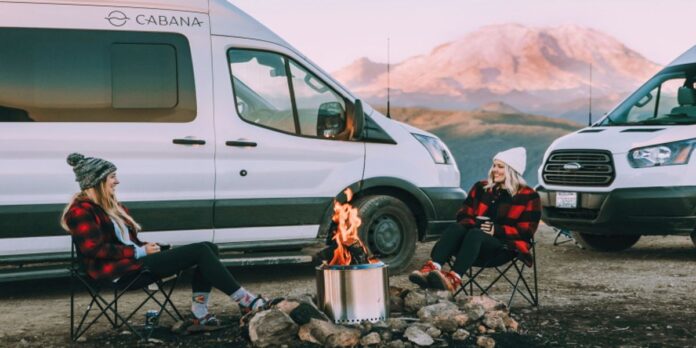In December 2023 I wound down my first startup, Cabana. I have
always been “entrepreneurial,” but always in large organizations – a so-called
“intrapreneur.” Cabana was the first time I took the plunge and started
something on my own, with no safety net.
Cabana was envisioned as a mobile hotel room (actually a network
of thousands of mobile hotel rooms) that could pop up wherever and whenever you
wanted whether that was: cliffside in southern Utah, a destination wedding in a
place with no lodging, or hundreds of units popping up at a music festival.
Subscribe to our newsletter below
So superficially we looked like #vanlife, but aspirationally we
were aiming for something much bigger. To achieve our vision we need to remove
all friction from the rental experience, generate enormous demand, design
vehicles usable by anyone – not just hobbyists – and build a back office for
the “hosts” that would own and operate Cabanas.
There are three questions that I think are fundamental to the
Cabana story:
Was venture the right tool?
Money is a tool that you use to build something, and money comes
in different flavors. You can bootstrap a company, take on debt or take in
outside investment. The right flavor depends on what you are trying to build.
If we were building a van rental company or an RV rental company, venture
capital would not make sense. But we were trying to build something that was
transformative and that transformation needed to happen quickly and at a big
scale – so venture capital was the right tool. Whether it made sense as a
venture investment is a different question.
What did we need to do to execute?
In the first board meeting, we identified three things we needed: extreme
product market fit (aka lightning in a bottle), strong unit economics and an
asset-lite model. In the summer of 2021 we had these nailed. We had just
raised a Series A and lined up $24.5M in fleet financing that covered 100% of
our vehicle cost. We had 300 vehicles on order and a manufacturer lined up
to build them. We were poised to 8x our revenue in one year.
So what happened?
COVID created a huge tailwind from a public relations and brand
standpoint but an even bigger headwind: supply chain disruption.
In the summer of 2021 we had 300 vans on order, a manufacturer lined up to
build them and financing ready to pay for them. By the late fall of 2021 the
situation had flipped. The global auto industry was in free fall due to a semiconductor shortage. Ford shrunk our order from 300
to 25.
You need to be able to cut ties with past practices or products as soon as it is clear they are creating drag on achieving your goals.
Scott Kubly
In the face of smaller volumes, our manufacturer backed away due to lower
volume Our lender could no longer underwrite the term sheet they offered due to
declining auto sales. We spent 2022 revamping our supply chain and 2023 going
all in on our “host” model. Over 800 people had applied to become Cabana “hosts.”
However, by the time we got those things lined up the credit climate had changed, we had debt that we could not restructure after the 2023 banking crisis, and our cash on hand didn’t give us the runway to wait out the macro economy.
Blaming macroeconomic events doesn’t offer much in the way of
lessons, and I am not sure that perfect execution could have allowed us to
weather the storm.
However, it is clear in hindsight that we had some execution errors that made
us far from perfect:
- Didn’t find the right leader for our hardware team until it was
too late
My technical co-founder quit after six months. He was wired for an
early stage startup in many ways, except the most important – he decided it
wasn’t for him. We tried four other people before we found the right leader.
It took too long to find the right person: someone willing to move
quickly, make decisions with incomplete information and operate with an “owner’s”
mindset. And, when I realized we had the wrong person, I took too long to make
a change.
- Too much software engineering on something that didn’t create
long-term value
A core part of our vision was building a contactless rental
experience and a booking system that connected into channel managers – making
our vans findable by those searching for hotels.
We started with a white-label software solution from an RV rental marketplace. It
was clunky, poorly supported, and it wasn’t built to integrate with other
distribution channels, but it allowed us to get started. As we built our brand
over 90% of our demand came directly to us.
In hindsight, we spend too many engineering resources integrating with a legacy
van rental platform. It complicated engineering, created operational complexity
and just took too long.
- The pivot to an asset-lite model came too late.
We planned for an asset-lite “host” model from the very beginning,
but there were always reasons we held off. This was a complicated
business, and we wanted to get the kinks out before involving external
owner-operators.
We wanted to make sure that: we understood
day-to-day operations, van production could scale, our software worked and
demand was strong. We wanted to prove good unit economics. We spent too long
“dogfooding” our product, spread ourselves too thin and burned cash on local
operations that “hosts” could operate profitably. Our hosts ran leaner than us
and produced stronger margins. This focus on optimizing operations we
ultimately would not run was another opportunity cost.
The clear theme running through all of these is “opportunity
cost.”
Every day counts and focusing on the wrong thing, even briefly, makes success
less likely. That means having the fortitude to make personnel changes
incredibly quickly, even if it feels unfair to the individual. You need to be
able to cut ties with past practices or products as soon as it is clear they
are creating drag on achieving your goals. Even more than money, the most
precious resource we had was time.
Lastly, I have some learnings specifically for the travel
industry.
The outdoor industry is a sleeping giant. More than 60 million American
households camp annually and more than 90 million consider themselves campers. Glamping,
the fastest growing category in outdoor, is only growing that number. The
industry is highly fragmented in the tech space and much of the inventory is
dominated by archaic, small operators.
Consumers desperately want a metasearch engine that can come in and aggregate
all the inventory in a single location. Maybe someday…
About the author…
Scott Kubly founded Cabana in 2019 and was the CEO until the company shut down in December.


